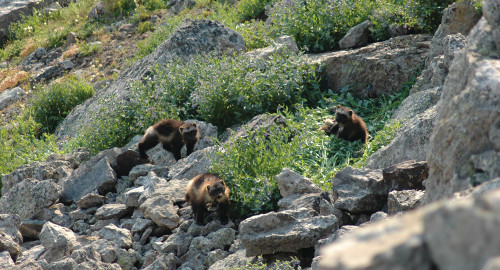Wolverines may be listed as threatened
By Sean Forbes Explorebigsky.com Contributor
As difficult as it might be to chase Bigfoot through the woods, searching for Gulo gulo – more commonly known as a wolverine – might actually be a bigger challenge in the higher elevation rock, snow and ice of the Northern Rockies.
The picture emerging from a new study – led by Dr. Robert Inman, the new Executive Director for the Craighead Institute – paints wolverines as solitary travelers patrolling territories between 300-750 square miles, hunting, scavenging and caching the leftovers in nature’s refrigerator along the way.
The first telemetry study of wolverines in the Greater Yellowstone, the decade-long project that Dr. Inman led while with the Wildlife Conservation Society, focused on the Madison Range between the Spanish Peaks and Hebgen Lake, the Gravelly Range, the Centennial Mountains and south into Grand Teton National Park. Capturing 40 animals with the use of about 100 trap sites, Inman was looking for “everything” – their food habits, home range size, habitat use, survival rates, causes of mortality, reproductive rates and den sites.
What he found was a portrait of a unique and uncommon creature.
“[They’re] basically born wearing snow shoes,” Inman said, explaining that the 20- to 30- pound animals have paws four inches wide and up to six inches long. This allows them to travel efficiently in rugged, mountainous terrain, particularly in deep snow.

One study subject known as M304 traveled from Grand Teton to Pocatello, Idaho, and back in just over two weeks, and a short time later made the roundtrip to Gardiner, Montana and back in a week.
“When we pulled the data off the GPS collar, we opened up the map that has the points on there, and our jaws dropped,” Inman said. “It really opened our eyes to, holy cow, these animals are capable of moving incredible distances over short periods of time, especially young dispersing individuals.”
The researchers did all the capture work during winter, Inman said, because “if we put baits out in the summer trying to catch wolverines, we’d catch bears instead.”
Yet even during warmer seasons, wolverines, the largest members of the weasel family, remain elusive. “People hardly ever see wolverines even though they’re around. When there [are] five of them in the entire Madison Range, you can begin to see why that’s the case. The odds of running into one are slim to none.”
Those odds are largely responsible for the numerous petitions submitted to the U.S. Fish and Wildlife Service in the last 19 years seeking protection for wolverines, which in turn have raised the demand for information and prompted studies like Inman’s. With his effort and the listing process wrapping up in August 2014, many expect that the animals will be added to the list of threatened species – but perhaps not for reasons one would expect.
CAUSE FOR CONCERN
Like many other species considered predators around the turn of the 20th century, wolverines were nearly eliminated from the Lower 48 by poisoning practices common at the time. Recovering remarkably well – after poisoning practices were eliminated and trapping regulated – wolverines again occupy much of their historic terrain in the northern Rockies.
Despite population estimates for some of the study’s mountain ranges falling between five and 15 individuals, wolverines have generally survived their conflict with humans.
“It’s important to point out that the biology suggests that number is probably the same as it was 500 years ago,” Inman said.
After floundering through chest-deep snow to gather data on animals that can be hard to find even while wearing radio collars, Inman and his co-workers in the WCS study found their most troubling characteristic, given current climate trends, was just how well adapted wolverines are for cold temperatures and snow.
Wolverines today inhabit a desolate, delicate niche where heavy snow packs persist well into spring – places like Canada, Alaska, the Cascade Mountains of Washington and Oregon, and the Northern Rockies. Warming temperatures could force the animals to compete more for precious food resources with other carnivores that access the highest elevations if they are not covered in deep snow and with insects and bacteria.

No one can say for certain what would happen without the protection of winter.
WHAT’S NEXT?
Assuming wolverines will be protected under the U.S. Endangered Species Act, and that the climate will remain a contentious issue, Inman’s work will be essential in helping define what comes next.
In 2004 and 2008, for example, his work was cited in the creation of management units for the Montana trapping season.
“A lot of [our changes have] been based on research, and the most recent stuff was changed based on his work, in terms of identifying … how many animals and what harvest rates should be,” said Brian Giddings, Montana Fish, Wildlife and Parks Furbearer Coordinator.
Federal Endangered Species Act protection would eliminate the trapping season.
The WCS study also suggested other options including continued population monitoring, maintaining connective corridors between higher-elevation habitats, and reintroducing the species to the mountains of Colorado.
With the details still to be formed, Inman addressed the issue of funding through the example of the Pittman-Robertson Act – which puts money generated through the sale of firearms and archery equipment into a state coffer designated for conservation projects.
“It’s been the most successful model for reestablishing populations and managing wildlife anywhere in the world,” he said.
Having revived more prominent game such as whitetail deer, black bear and wild turkey, the expansion of that system – to include other gear like tents and packs – could have the same beneficial effect on non-game species like the wolverine.
“Society said that it wants to conserve species when it enacted the endangered species act,” Inman said. “But until we develop a dedicated funding system that enables us to do the work that must be done to conserve habitats and monitor populations, we are just talking.
“Sportsmen figured out how to do that in 1937 with the Pittman-Robertson Act. We just need to follow that example and get it done for the broader range of species that we now ask our state wildlife agencies to steward.”
Sean Forbes is a freelance writer based in Bozeman, Montana, where chasing stories only occasionally gets in the way of playing outside. Dr. Robert Inman is continuing to research wolverines, now at the Craighead Institute in Bozeman. This story was adapted from one originally printed in the summer 2013 issue of Mountain Outlaw magazine.













